ISSN ONLINE(2278-8875) PRINT (2320-3765)
ISSN ONLINE(2278-8875) PRINT (2320-3765)
Seema Kumari1, Manpreet Kaur2, Birmohan Singh3
|
| Related article at Pubmed, Scholar Google |
Visit for more related articles at International Journal of Advanced Research in Electrical, Electronics and Instrumentation Engineering
Visual surveillance system is one of the most challenging research topics in the recent decades. It is a key technology to fight against the problem of crime, terrorism, public safety like in banks, shops, private buildings etc. In this paper, we have analyzed moving object detection techniques, the frame difference and the approximate median method. The frame differencing has been adopted for the reference frame and the step length. We have proposed the moving object detection as well as object tracking by using the modified frame difference method. In the proposed surveillance system for video captured by single camera is considered for the space under the observation. The proposed methodology is tested on ten videos and it is found that this method is capable of detecting multiple moving objects clearly. The results are quite satisfactory.
Keywords |
| Visual surveillance, background subtraction, frame difference, moving object detection, object tracking. |
I. INTRODUCTION |
| Visual surveillance or video surveillance is the fastest growing field with numerous applications including traffic monitoring, human activity surveillance, people counting and other commercial applications. In all these applications extraction of moving objects from the video sequence is the key operation. Since the camera is not in motion here, the inherent ambiguities of ego-motion is not considered and the scene structure can be discarded at the very beginning [3]. Video surveillance of human activity usually requires people to be detected and background subtraction is a powerful mechanism for identifying changes in the video sequence [1]. Identifying moving objects and tracking from a video sequence is a fundamental and critical task. The background subtraction method is a common approach which identifies the moving objects from the portion of video frames that differs significantly from the background model. The basic idea in background subtraction is to classify the pixels as background or foreground by thresholding the difference between background image and the current image [6]. The paper is organized as follows: Section 2 summarizes the related research works, Section 3 deals with the proposed methodology, experimental results are given in section 4, conclusions are discussed in section 5 followed by references. |
II. RELATED RESEARCH WORK |
| A number of methods tried by the researchers for detection and tracking of moving object have been reported in the recent years. Falah E. Alsaqre and Yuan Baomng [3] presented an algorithm to perform moving object tracking for video surveillance systems. The moving objects extracted by the background subtraction method. It used two basic information structures such as a list of all active moving objects and their features and information about matching. Jiang Dan and Yu Yuan [4]proposed the method for multiple objects motion-tracking based on both region and feature tracking for the realtime surveillance system. An adaptive background subtraction method was adopted for motion detection, and real-time tracking was realized by extracting the features of moving objects and matching. The tracking method could be achieved efficiently in different lighting and weather conditions.Dunne and Matuszewski [5] presented a localized object detection technique. It used a localized temporal difference change detector and a particle filter type to detect possible trackable objects. It found a point within a detected object at which a particle filter tracker might be initialized.Sudheer Reddy Bandi et al. [6] had analyzed three background modeling methods such as median value, change detection mask and histogram based modeling technique and two background subtraction algorithms namely the frame difference and approximate median. The best result was obtained with median value method for background modeling and frame difference method for background subtraction but there was the problem of errors when the scene changed in the part of the background. Pranab kumar dhar et al. [7] had proposed an enhanced edge localization mechanism and gradient directional masking to detect moving object in video surveillance system. The appropriate directional masking was used to detect moving object. |
| We have proposed the moving object detection as well as object tracking by using the modified frame difference method. In the proposed surveillance system single static camera is connected with the space under the observation. The paper provides an effective method for moving object detection and tracking with the stationary background scene. In the proposed methodology, first the videos are separated as frames and pre-processing methods are used for color conversion and to subtract the foreground object from the background after the selection of a reference frame. The moving object is detected by using the modified frame difference method. The moving object is then tracked by constructing the boundingbox. |
III. PROPOSED METHODOLOGY |
| The proposed methodology has been divided into different modules. Video is read frame wise in the first module. The first frame is initialized as the reference frame at the beginning of the system. The intensity values of the current frames are subtracted from the reference frame to extract the foreground image. The morphological operations are performed to remove the noise.The proposed method aims to extract the moving objects from an input video sequence and then tracking the object as shown in Figure 1. |
| A. INPUT VIDEO |
| The input video format taken in this paper is AVI. AVI stands for audio video interleave. An AVI file actually stores audio video data under the format RIFF (Resource Interchange File Format). In AVI files, audio data and video data are stored next to each other, so that synchronous audio with-video playback can be allowed. Audio data is usually stored in AVI files in uncompressed pulse code modulation format with various parameters. Video data is usually stored in AVI files in compressed format with various parameters and codec [8]. The video captured is in AVI format and this video is read as frames which are 29 frames per second.The method is tested on ten input videos. The experiment is done to check the efficiency of the system. |
| B. MOVING OBJECT DETECTION SYSTEM |
| This section of the proposed methodology consists of four subsections that is referenced frame selection, step length selection, morphological operations and the detection part. |
| a) Reference Frame Selection (RFS) |
| The background subtraction method used for separating the moving object from its background requires an initial reference frame or background frame before updating the next sequence [7]. While selecting the reference frame, care is taken to avoid the overlapping of the image or the chances of missing any important information from the video sequences.We have selected first frame as the reference frame. |
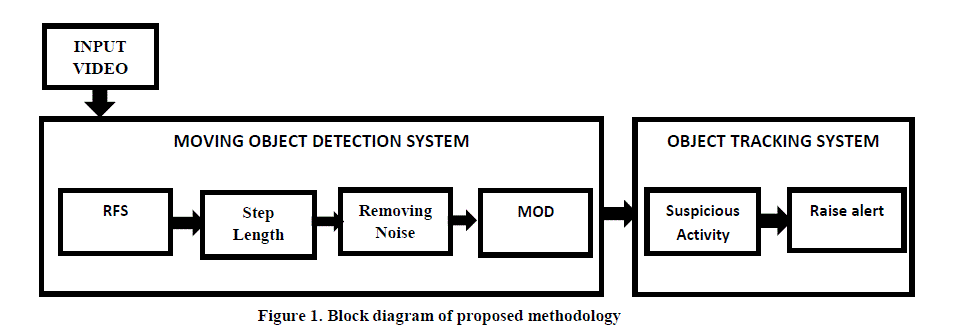 |
| b) Step Length Selection |
| The proper step length is selected by subtracting the reference frame and the next frame with an experimentally selected step length. The small step length will increase the computational time and other overheads while bigger step length will reduce the computational time but we will miss some important information. So the appropriate step length has to be selected which we have selected on the basis of experimental results. The step length of two is selected in this paper after the selection of reference frame. The results achieved for two different videos are shown in Figure 2.Figure2 shows the selection of proper frames to get the frame difference results. Improper selection of reference frame and step length may result in overlapping or missing of important information from the video. Figure 2(a), 2(d) indicates reference frame. Figure 2(b), 2(e) are the current frames, Figure 2(c) and Figure 2(f) shows the result output achieved after the frame differencing.It is clear from the Figure 2(c) that there is an overlapping and repetition of a moving object. The moving object is indicated in a circle marked with red and the overlapping or repetition is in circle marked with green. Figure 2(f) shows the proper selection of the reference frame as the moving object is detected clearly without any overlapping, repetition and the loss of information. |
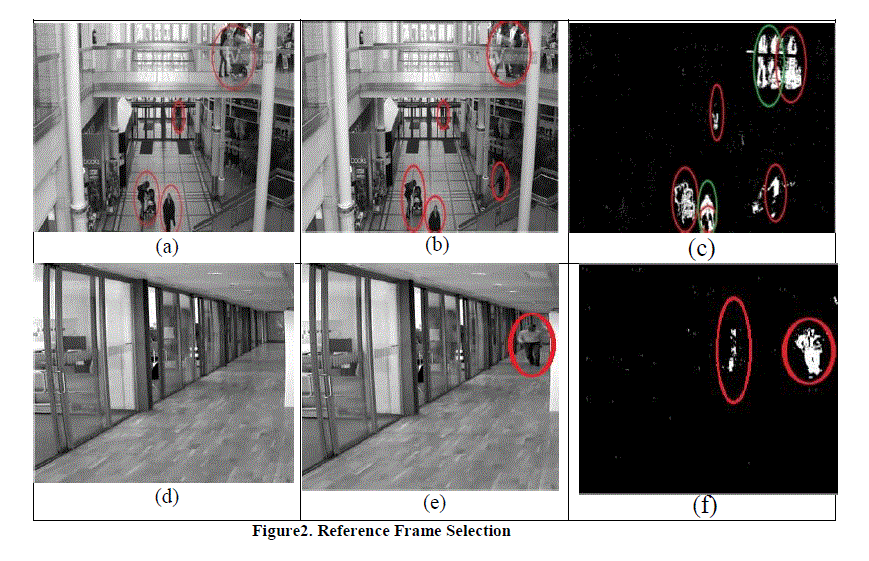 |
| c) Removing Noise |
| In this paper the morphological operations are performed to remove the noise. The morphological operations are performed on binary images where the pixel values are either 0 or 1. Morphology is a broad set of image processing operations that process images based on shapes. Morphological operations apply a structuring element to an input image, creating an output image of the same size. The most basic morphological operations are dilation and erosion. In a morphological operation, the value of each pixel in the output image is based on a comparison of the corresponding pixel in the input image with its neighbors [8]. Some noises occurring due to the factors like light variation and airborne effects affects the performance of object detection. These noises are affecting the performance and accuracy of the system, thus needed to remove. Erode and dilate operations are used to remove the noise. |
| d) Moving Object Detected (MOD) |
| It is an important section of this paper, here the video which is converted to frames are compared to the reference frame and the frame which contains the moving object in it shows the difference in the movement of the objects. Background subtraction is one of the key techniques for automatic video analysis, especially in the domain of video surveillance where it needs to be the first step to detect the moving object in the scene. It is a powerful mechanism for detecting changes in a sequence of images. It is used to find the total or sudden change in intensity of the video. There are different methods are of background subtraction, these methods are implemented using varying complexity [6]. In this paper the modified frame difference method has been used to get the better and efficient output. |
| i. Frame Difference Method |
| The frame difference method is a kind of algorithm for detection of moving objects using adjacent frames difference in a video sequence. The frame difference method is the simplest method to examine the changes between the adjacent frames in a video sequence. Its basic principle is carrying on the change examined by using the similarity of adjacent frames in video sequences, through the difference of frames, then threshold the difference image and determine moving object. In the process of moving object detection, this method compares the gray value of corresponding pixels from continual two frames images in the image sequence directly, and calculates their difference value according to rule[6]. For each pixel, the difference is compared as per equation (1). |
| is the current frame,−1 is the previous frame and k is the frame number. If the difference value is bigger than the threshold value, pixels are taken as foreground or moving region of the scene else it is 0. |
| ii. Approximate Median Method |
| This is a recursive method for estimating a background model. Each pixel in the background model is compared to the corresponding pixel in the current frame, and then it is incremented by one if the new pixel is larger than the background pixel and decremented by one if smaller than the background pixel. A pixel in the background model converges to a value where half of the new incoming pixels are larger than its value and half are smaller. This value is known as the median. The approximate median has been selected because it handles slow movements also, which are often the case in our environment, better than the frame differencing method. Here on this method, background frame is updated each time, if the deviation is either more than threshold value or it is less than the threshold value [6]. |
| iii. Modified Frame Difference Method |
| The modified frame difference method is a kind of algorithm for detection of moving objects using frame difference at selected step length in a video sequence. The modified frame difference method is the simplest method to examine the changes between the frames in a video sequence. Its basic principle is that the changes is examined byusing the similarity of frames in video sequences at selected step length, through the difference of frames, then threshold the difference image and determine moving object. In the process of detecting moving objects, this method compares the gray value of corresponding pixels from the frames images in the image sequence directly, and calculates their difference value according to the given algorithm. |
| The major disadvantage of the frame difference method is that, the foreground is not detected clearly, again in approximate method the foreground is detected clearly but the background modeling is to be done. The background modeling is hard and time consuming, so the computational time is much more than the frame difference method. In the modified frame difference method, the foreground pixels are set to 1, if the deviation is more than the threshold value else it is set to 0. Background modeling is not required in modified frame difference method. The main advantage of the modified frame difference method is that the foreground is detected clearly and since background modeling is not required here, it takes less computational time. The algorithm for the modified frame difference method is given below: |
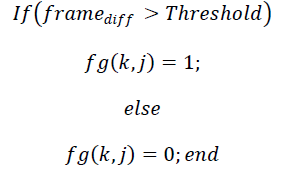 |
| It gives the algorithm for modified frame difference, where if the frame difference (ïÿýïÿýïÿýïÿýïÿýïÿýïÿýïÿýïÿýïÿýïÿýïÿýïÿýïÿýïÿýïÿýïÿýïÿý ) is above the value of manually selected threshold value then the foreground (ïÿýïÿýïÿýïÿý) will be 1 else 0, provided the foreground is set at 0 initially. In the proposed methodology, first the frame gap is selected by using the frame differencing. The background subtraction is performed using proposed modified frame difference method to obtain the moving region efficiently. The comparison between the above three methods is shown in Table1. |
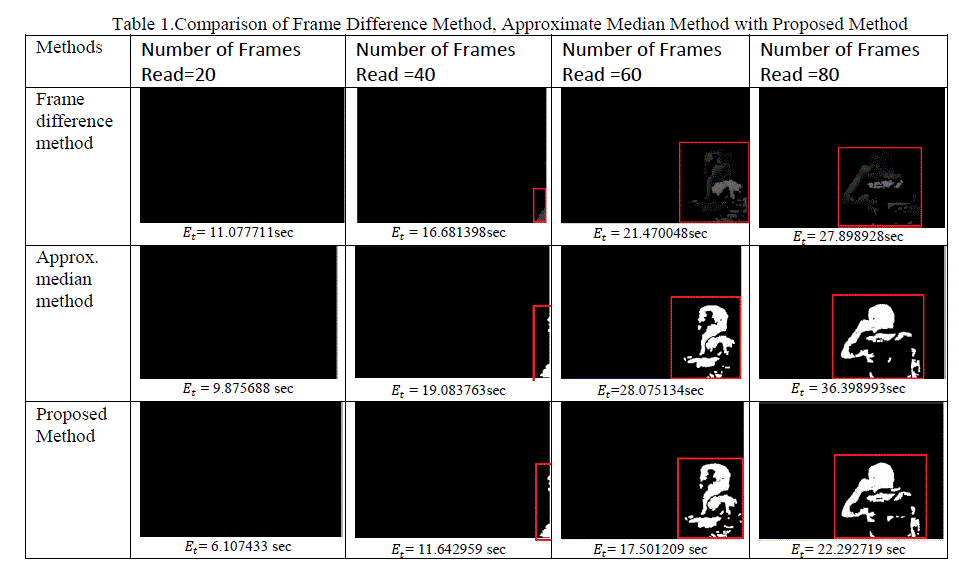 |
| Table1 shows the number of frames read by three methods in different elapsed time (ïÿýïÿýïÿýïÿý ). Here one video is read upto 20th, 40th, 60th, and 80th. The computational time(ïÿýïÿýïÿýïÿý ) is recorded upto 20th frame for three different methods which is 11.077711 seconds for frame difference method, 9.875688 seconds for approximate median method and 6.107433 seconds for the modified frame difference method. Similarly for the 40th frame it is 16.681398 seconds, 19.083763 seconds and 11.642959 seconds. Again for 60th frame it is 21.470048 seconds, 28.075134 seconds and 17.501209 seconds so on. Hence it is clear that the modified frame difference method is computationally faster than the other two methods. From the table is concluded that the output is more clear by using the proposed method. Hence the method maintains more accuracy than the other two methods. It can be concluded from here that the use of proposed method takes less elapsed time to read the equal number of frames as compare to frame difference and approximate median method. The Table1 shows that this method has more computational speed. |
IV. OBJECT TRACKING SYSTEM |
| This section of the proposed methodology consists of two subsections that is tracking suspicious activity and then raising an alarm. |
| A. Suspicious Activity |
| Object tracking is the method for detection of moving objects of interest and plotting its route by analyzing them. The main objective of the object tracking is to detect the moving object in a video sequence. The bounding box is constructed to isolate the area of interest in the video sequence and is similar to key region processing. This can be made easily by calling the (Bounding Box) property of the (regionprops) function [6]. The rectangular shape boundingbox is constructed; the area of the moving object is labeled inside the rectangle with the dotted linestyle of red edge color in the output. As the object is moves in the system, it is detected by moving object detection system then by constructing the boundingbox the object is tracked step by step according to its movements continuously. |
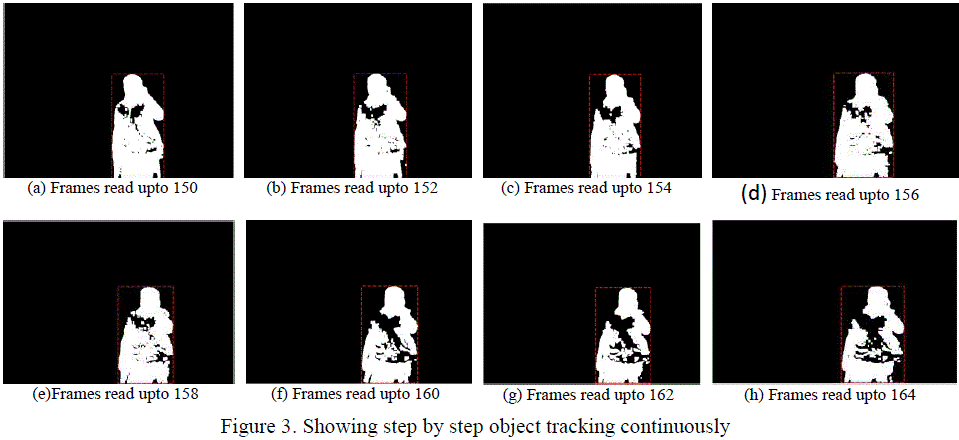 |
| Figure 3 shows the tracking of the object detected, step by step according to the selected step length. Figure 3(a) shows that, as the movement is detected in the area under the observation. It is then tracked for the first time and from that instance the object is tracked continuously from one frame to the next frame as shown in Figure 3(b), 3(c), 3(d), 3(e), 3(f), 3(g), and 3(h). It shows that even the slow movement is also detected and tracked easily. |
| B. Raise Alert |
| As the moving object is tracked a recorded sound is generated to make the system alert. Every time when there is any movement in the system is being tracked then the sound is to be generated. The sound generated can be the beep sound or any other music we want to input to the system. The music input to the system is in wav format. Waveform Audio File Format (WAVE, or more commonly known as WAV due to its filename extension) is a Microsoft and IBM audio file format standard for storing an audio bitstream on PCs [9]. Using the beep sound to generate alarm takes less computational time than generating any other sound. |
V. EXPERIMENTAL RESULTS |
| Testing the system, first begin with loading the acquired video to the software. Test videos have been captured with the camera by putting it in a static position inside a small room. During the testing, ten videos are input to the system one by one. The video has been captured in different conditions, to check the accuracy of the system.The proposed method gave a very satisfactory output in detecting and tracking the moving object then raising an alarm. It gives more computational speed in terms of Elapsed time. Different video has been captured from the single fix camera. Five test videos are taken as an example to check the performance of the method which is shown in given tables. |
 |
| The techniques which we discussed in our method frame difference method, approximate median method and modified frame difference method. The best output has been achieved at a threshold of 20 using the modified frame difference method in terms of computational time, accuracy and computational complexity. |
VI. CONCLUSIONS |
| The proposed methodology extracts the foreground from the input video effectively and tracks the moving object. The methodology provides the flexibility of choosing the threshold value. The small and slow moving object can be detected accurately. Computational speed is faster in terms of elapsed time. An alarm is raised as the moving object is detected and tracked in the system. Future work will be directed towards achieving the following issues such as: Object classifications, Shadow removal and removing false alarm. |
References |
|